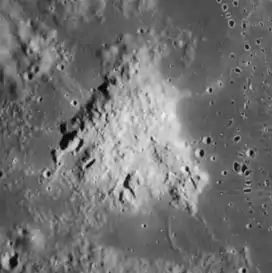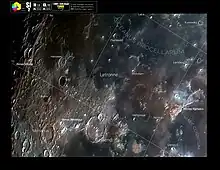Mons Hansteen
Mons Hansteen is a mountain on the Moon, also known as Hansteen Alpha (α), named after Christopher Hansteen. It is roughly triangular in shape and occupies an area about 30 km across on the western margin of Oceanus Procellarum, southeast of the crater Hansteen and north of the dark-floored crater Billy. It is thought to be an extrusion of volcanic material that is younger than the crater Hansteen, with most of surface volcanic ash been deposited 3.5-3.74 billion years ago.[1]
| Mons Hansteen | |
|---|---|
 Lunar Orbiter 4 image | |
| Highest point | |
| Listing | Lunar mountains |
| Coordinates | 12.1°S 50.0°W |
| Naming | |
| English translation | Hansteen mountain |
| Language of name | Latin |
| Geography | |
| Location | Near side of the Moon |
| Geology | |
| Mountain type | Lunar dome |

The Mons Hansteen belongs to rare class of non-mare moon volcanoes.[2]
Composition
The extruded material is significantly enriched in silica, and strongly depleted in iron and titanium oxides compared to surrounding mare terrain.[3] Initially, it was believed its lavas are not as evolved as in Compton–Belkovich Thorium Anomaly,[4] but by 2004 the low thorium enrichment signal was attributed to small size of volcanic complex, making it composition compatible with highly processed silicic lavas.[5] By 2013, a patchy deposits of magnesium spinel were detected in the central and western parts of the volcanic dome.[6] The spinel-rich areas are associated with boulder fields, and fringed by areas showing a sign of hydration,[7] with 4-8% of mineral by weight been hydroxylated.[8]
The average bulk density of material in Mons Hansteen is extremely low, been equal only to 1500–2000 kg/m3.[9]
See also
References
- Hansteen Mons: An LROC geological perspective
- Wilson, J. T.; Eke, V. R.; Massey, R. J.; Elphic, R. C.; Jolliff, B. L.; Lawrence, D. J.; Llewellin, E. W.; McElwaine, J. N.; Teodoro, L. F. A. (2014), "Evidence for explosive silicic volcanism on the Moon from the extended distribution of thorium near the Compton-Belkovich Volcanic Complex", Journal of Geophysical Research: Planets, 120: 92–108, arXiv:1409.1209, doi:10.1002/2014JE004719, S2CID 52241264
- HANSTEEN ALPHA: A SILICIC VOLCANIC CONSTRUCT ON THE MOON.
- Hansteen Alpha: A volcanic construct in the lunar highlands
- REVISITING THE INTERPRETATION OF THORIUM ABUNDANCES AT HANSTEEN ALPHA.
- EXPOSURES OF Mg-SPINEL ON AN EVOLVED SILICIC LITHOLOGY HANSTEEN ALPHA ON THE MOON
- MG-SPINEL EXPOSURES WITHIN SILICA RICH SETTING ON HANSTEEN ALPHA: PROBING THE GEOLOGIC CONTEXT
- ENDOGENIC WATER/HYDROXYL ANOMALY ASSOCIATED WITH LUNAR SILICIC DOMES DETECTED BY CHANDRAYAAN-I MOON MINERALOGY MAPPER (M3) INSTRUMENT AND ITS IMPLICATIONS.
- The Bulk Density of the Small Lunar Volcanos Gruithuisen Delta and Hansteen Alpha: Implications for Volcano Composition and Petrogenesis
External links
- Mons Hansteen: A Window into Lunar Magmatic Processes, Lunar Reconnaissance Orbiter Camera (LROC) article, Posted by Brett Denevi on April 10, 2017